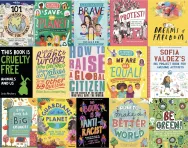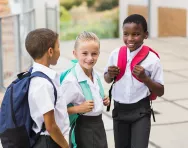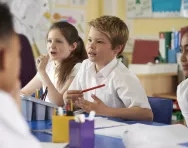TheSchoolRun.com closure date
As we informed you a few months ago, TheSchoolRun has had to make the difficult decision to close due to financial pressures and the company has now ceased trading. We had hoped to keep our content available through a partnership with another educational provider, but this provider has since withdrawn from the agreement.
As a result, we now have to permanently close TheSchoolRun.com. However, to give subscribers time to download any content they’d like to keep, we will keep the website open until 31st July 2025. After this date, the site will be taken down and there will be no further access to any resources. We strongly encourage you to download and save any resources you think you may want to use in the future.
In particular, we suggest downloading:
- Learning packs
- All the worksheets from the 11+ programme, if you are following this with your child
- Complete Learning Journey programmes (the packs below include all 40 worksheets for each programme)
You should already have received 16 primary school eBooks (worth £108.84) to download and keep. If you haven’t received these, please contact us at [email protected] before 31st July 2025, and we will send them to you.
We are very sorry that there is no way to continue offering access to resources and sincerely apologise for the inconvenience caused.
How to get your child interested in the news

Now more than ever, the news is all around us – on TV, on the radio, in newspapers and magazines and online. And whether we like it or not, our children are consumers of current affairs, too.
As parents, we may be inclined to try to shield our children from the news – so much of it is bad, after all – or to assume that young minds aren’t interested in what may seem to be adult issues. But on the contrary, it’s important that they know what’s going on in the world.


Start a unique learning programme!
- Weekly programme for each school year
- Worksheets sent direct to your inbox
- Keeps your child's learning on track
‘Keeping up to date with what’s in the news is one of the best ways we can understand more about the world around us,’ says BBC Newsround presenter De-Graft Mensah. ‘It allows children to have important and educated conversations with friends and family, too.’
Lewis James, editor of Newsround, agrees. ‘Children are the citizens of the future, so developing an interest in current affairs at an age that is right for them is important for our democracy,’ he explains.
The right of children to know what’s going on in the news is even enshrined in law: the UN Convention on the Rights of the Child states that they ‘must have access to news and information that affects them.’
So how can we help our kids to take an interest in the news in a way that’s safe and age-appropriate?
Use child-friendly sources
Put a broadsheet newspaper in front of a child, and it’s unlikely that they’ll be enticed to open it up. But give them a newspaper or magazine that’s pitched at them, or tune into a children’s news broadcast, and they’ll often dive in with relish.
Child-friendly sources of news draw them in in many ways, from the mixture of stories to the language used.
‘We may have a story about the US election next to one about a new species of dinosaur,’ Lewis explains. ‘The aim is that children can access something they are interested in at all times.’
Don’t shy away from difficult topics
We naturally want to protect our children, but telling them about stories of global significance, even if they’re distressing, is important if they’re to understand what’s happening in the world and take an interest in it.
Talking to your child about upsetting events can be difficult, but trying to sugar-coat it does them a disservice.
‘We don’t want to patronise children, and it’s important that we cover major news events, whether they’re happy or distressing,’ says Natasha Littleton, marketing manager for the children’s weekly newspaper First News.
In these situations, there are ways to explain what’s happening with honesty and sensitivity. For example, you can take care not to use alarmist language, and reinforce the fact that these occurrences (whether that’s the Covid-19 pandemic or George Floyd’s murder) are extremely rare – that’s why they’ve made the headlines.
You can also highlight the good that can come from upsetting situations, pointing out the people who are helping, or explaining that when bad things happen, it often makes people determined to change things for the better.
‘We always find that within a distressing news story such as an earthquake or bombings, there are beautiful stories of positivity – people working together to help others,’ says Natasha.
Put children at the heart of the story
We all find the news easier to engage with if we can see how it affects people like us, and children are no different. So when you’re trying to spark their interest in current affairs, you’re more likely to succeed if you put children at the heart of the story.
During the pandemic, for instance, the main issue affecting children was the closure of schools, so using that as the way into discussing it would be more likely to draw them in than focusing on the R rate.
‘We always strive to put children at the forefront of everything we do, and aim for children to tell their own stories in our pieces,’ says De-Graft.
Share the news together
Making the news part of family conversations will help your child take an interest in what’s happening, and it has other benefits, too.
It’s an opportunity to be a good role model by showing them that you’re interested in current affairs, to answer their questions, to give reassurance if something is worrying them, and to correct any misinformation they might have picked up.
You could do this on car journeys with the radio on, at the dinner table, by watching an episode of Newsround or reading a children’s newspaper or magazine together.
‘It’s so important to have news discussed at home and at school as part of children’s daily life,’ explains Natasha. ‘Make it a really positive experience – ask for their view on news stories and encourage them to ask questions.
‘It’s incredible seeing children growing in confidence and often being proud to show off a bit of their knowledge to parents and grandparents.’
Encourage critical thinking
One downside of being constantly bombarded with news from different sources is that it’s not always easy to discern what’s true and what’s not.
This can be a particular challenge for children, and when they’re talking about the news to each other, it can become rather like Chinese whispers.
Instead of simply correcting your child if they’ve got the wrong end of the stick, use it as an opportunity to make them think about what they’ve heard.
Does the story sound like it’s true? Is the person they heard it from likely to know what they’re talking about? Might it have been exaggerated for dramatic effect?
‘Engaging with and thinking about the news can develop critical thinking, which is useful in many areas of learning and in life more generally,’ explains Lewis. ‘All of us are susceptible to misinformation, and developing critical thinking at a young age is a really useful life skill.’
Keep it age-appropriate
Although it’s important not to dumb down what’s happening in the news, do take care that you’re presenting it in a way that suits your child’s age and level of understanding.
If the language is too advanced, or there’s too much jargon, or the story is too heavy, or they don’t understand the background, it’ll be hard to keep their interest.
Using news sources that are designed for children, like First News and Newsround, is an obvious way to make sure you’re presenting news in an age-appropriate manner, but you’re the best judge of your child’s stage of development.
‘We hear a lot from parents who read the news articles to younger children and have a general chat about what’s going on, while at the older level, children read the articles on their own (and often, so do the parents once the kids are in bed!) and it sparks general conversation throughout the week,’ says Natasha.
Make it varied
Often, the news is dominated by one topical issue (Covid-19 being a case in point), but children can easily get bored and switch off if they’re hearing the same thing over and over again. However, if they have access to lots of different stories, they’re more likely to engage.
‘We’ve found from research that children generally have a much wider range of news stories that they find interesting compared to many adults,’ explains Lewis.
So alongside talking about the key issue that’s on everyone’s minds, bring in other stories with a wide variety of subject matter – the birth of a giant panda, the introduction of e-scooters, or the opening of a new theme park can sit comfortably alongside stories about politics and the pandemic.
‘News isn’t just straight political stories, so find something your child is interested in and see what news exists on that,’ suggests De-Graft. ‘It might be a new game, a celebrity, a specific city or the latest zoo to have a new animal birth.’
Use other resources
The internet is a rich source of information that can help you explore tricky news concepts with your child, and develop their understanding of what’s going on.
YouTube videos and animations, the websites of charities, museums and galleries, podcasts, fact files such as TheSchoolRun's free Homework Gnome project explorer, the social media networks of children’s magazines and current affairs shows (used with adult supervision): all of these can help bring the news to life for your child.
Encourage their own journalism
Children needn’t just absorb the news passively – they can also get involved with making it by writing, recording or filming their own news stories about things that are happening in their lives, their community, or on a national or global scale.
To spur your child on, look for opportunities for them to share their writing. For example, they could write articles for a school newspaper, magazine or to be shared on their school’s website or in its newsletter; write letters to their local paper or MP; or write to a friend in another part of the country about something that’s going on in their area.
There are also several campaigns and competitions that they can get involved in. ‘Encouraging children to write news stories about their own life was a hugely popular activity in lockdown, and we have recently launched a home reporter competition to recognise the incredible efforts of children writing at home and in school,’ says Natasha.
Other opportunities to write or broadcast include the BBC Young Reporter competition (ages 11-18).
Help them take action
The news can be a good starting point for children to get involved in activities that make a difference.
If a particular story has grabbed their interest, think about ways that they could build on that – a story about plastic waste could inspire them to go litter-picking in their area, or a humanitarian disaster might prompt them to hold a bake sale in aid of the relief effort.
It’s a great way to build on what they’ve heard in the news and turn their interest into a real passion project.
Let them take the lead
Above all, remember that you can’t force your child to be interested in news, so take it at their pace.
Look for stories that interest them, but be prepared to move on if a conversation about a particular story is going nowhere, or if they’d rather listen to music than have the news on the radio.
‘Sometimes it’s important to take breaks from the news so you’re not constantly watching it,’ says De-Graft. ‘But ask your child questions about things happening in the world around them, not as a way to test them but to pique their curiosity. An interest in the world grows as you grow.’
With a gentle touch and a willingness to be led by your child, you can gradually turn them into a person who genuinely cares about current affairs.








